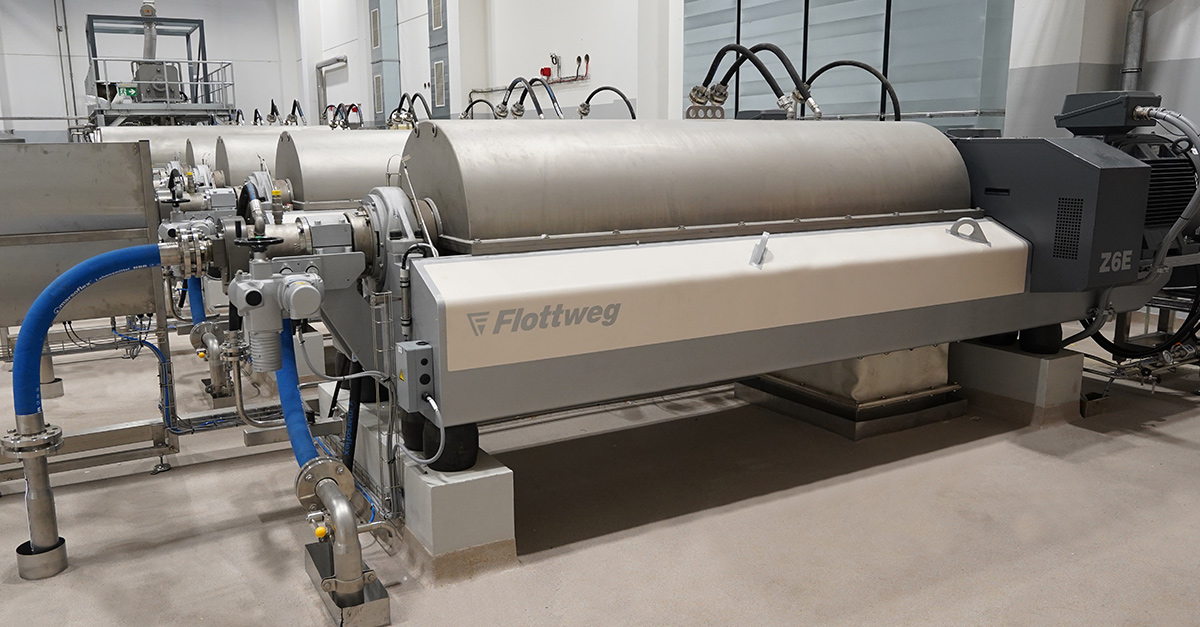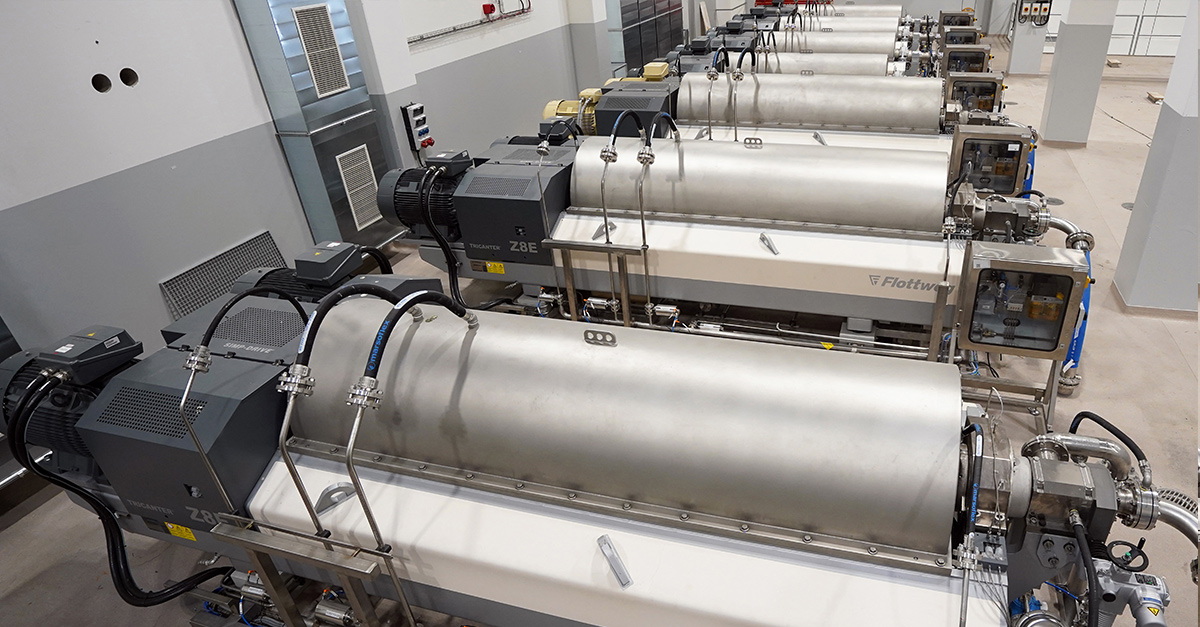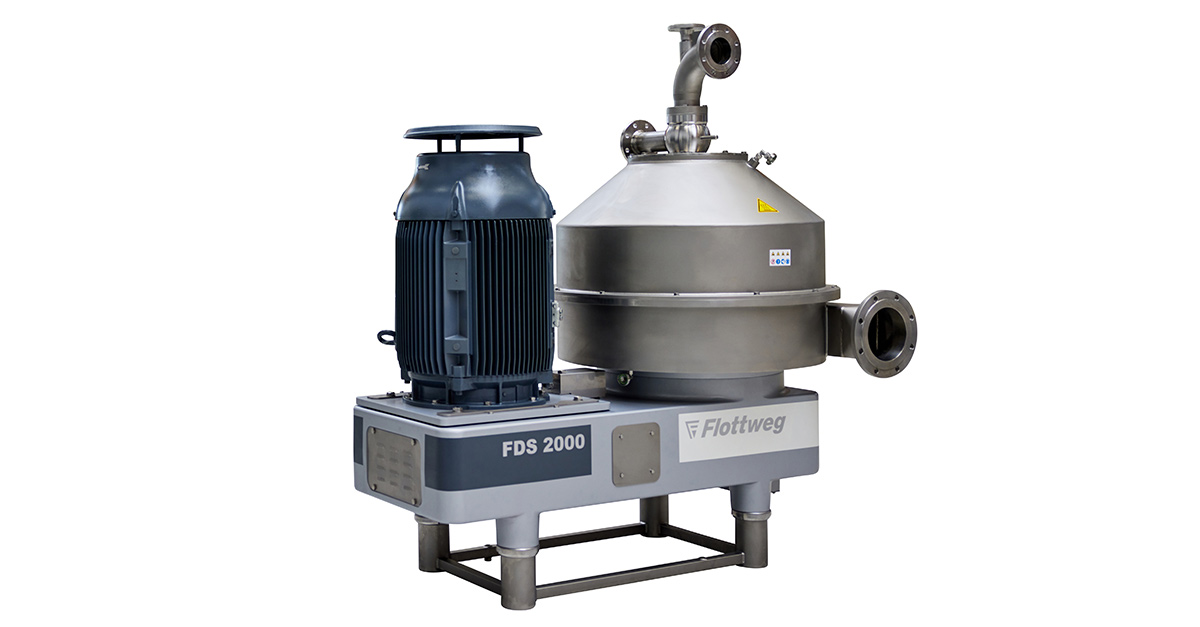2022-08-23
Twice as Strong – Use of the New Flottweg Nozzle Separator at Jäckering
Starch can be used in many processes – in the food industry as a binding or thickening agent in the production of baked goods, soups and sauces, in the paper and corrugated cardboard industry, and in the chemical, pharmaceutical, and cosmetics industries. It is an important natural product used in many areas of daily life. Starch processing, however, has its drawbacks: After all, various factors such as water consumption or the quality of the end product can have a major impact on the manufacturing process, which is clear proof that the process line has a lot to accomplish. Jäckering, a family-owned company, has been involved in the wheat business for more than 100 years, and has used the Lower Bavarian separation technology from Flottweg for almost a decade. Now, Jäckering has integrated Flottweg’s new family member, the nozzle separator, into the process.
 Jäckering has gained a lot of experience in wheat and wheat processing in more than 100 years.
Jäckering has gained a lot of experience in wheat and wheat processing in more than 100 years.A Family Business and Expert in Wheat: Jäckering
Founded in 1910, Jäckering Mühlen- und Nährmittelwerke GmbH is now a global company that produces and sells wheat flour, native wheat starch, and wheat protein for the food, pet food, and non-food industries. Across these industries, Jäckering focuses on great quality combined with conditions that are favorable for customers. Managing partner Michael Andreae-Jäckering is now the third generation to run the family business. Over the decades, Jäckering has become a true wheat expert with a very good understanding of the market, the conditions, and the challenges.
As the first producer of vital gluten in Europe in the 1950s, the production of wheat starch has since become the fastest-growing line of business for the company in recent years. “Since I started at Jäckering in 1981, I have seen the production of wheat starch develop from a few tons per month to several hundred thousand tons per year. We have always been committed to making production even more efficient and effective,” explains managing partner Michael Andreae-Jäckering. Objectives must be reevaluated every day due to the starch industry’s demanding challenges. Michael Andreae-Jäckering is also very familiar with this: “You've got to continually optimize things in many areas. The goal here is to achieve a good yield while using little water and energy, and you must coordinate the various by-products in the production process."
 Shareholder Michael Andreae-Jäckering has been working in the family business since 1981 and still sees a lot of potential for wheat starch as a raw material in the future.
Shareholder Michael Andreae-Jäckering has been working in the family business since 1981 and still sees a lot of potential for wheat starch as a raw material in the future. The Starch Process and Separation Technology – Made for Each Other
For starch production, wheat flour is broken down into its components: A- and B-starches, gluten/wheat protein, and pentosans. During the processing of wheat, it is crucial for the wheat protein in the starch to be separated from the starch. After the wheat is ground dry, water is added to wash out the starch in a step called the “wet process.” Separation technology is used in this process step to break up the suspension into individual components. In three-phase separation, the Flottweg Tricanter® centrifuges use the adjustable impeller to separate the A-starch solids phase from gluten and the B-starch “heavy” liquid phase and the pentosan liquid phase. Centrifuges serve as key equipment for solid-liquid separation processes and ensure maximum efficiency and high-quality separation results. This first process step is essential in order to ultimately obtain high-quality end products with maximum yield in a few subsequent steps. “The art of the wet process is to use as little water as possible while still maintaining a high-quality, cleanly separated starch,” explains Andreae-Jäckering. “This requires a lot of know-how about this complex process and its numerous recirculated elements.”
The nozzle separator is an additional component of the wet process responsible for refining the A-starch as a solid phase. It is mainly used when continuous separation of large quantities of solids from liquids is required along with maximum clarification or separation. Before refining the A-starch, it contains roughly 1.5% wheat protein and a dry matter content of approximately 52%. After the separation process, the protein content is 0.30% at the most. Depending on the separation task, the throughput of the nozzle separator can vary from 40 m³/h to 160 m³/h (or between 176 gpm and 704 gpm).
 Centrifuges act as key equipment in the starch process.
Centrifuges act as key equipment in the starch process. Flottweg Separation Technology in Use at Jäckering
Jäckering’s starch factory has been using Flottweg starch processing solutions for almost a decade, and Michael Andreae-Jäckering couldn't be more delighted: “After many years, we decided to use a Flottweg machine. It was a ‘veni, vidi, vici’ situation: We installed the machine, and after a few days it was already better than its predecessor. This convinced all of us at Jäckering to work more closely with Flottweg.” Based on these positive experiences and satisfaction with the results in the wet process, Jäckering finally decided to equip Flottweg’s separation technology in the new starch factory, which will process 900,000 tons of wheat annually in the future. Jäckering’s new starch factory uses a system designed completely by Flottweg, with two Z8E Tricanters®, one Z8E decanter, and four Z6E decanters. At Jäckering, all steps within the wet process are precisely coordinated with each other in order to obtain high-quality end products.
 Jäckering uses a completely designed system with two Tricanter® Z8E, one Decanter Z8E and four Decanters Z6E from Flottweg.
Jäckering uses a completely designed system with two Tricanter® Z8E, one Decanter Z8E and four Decanters Z6E from Flottweg.Flottweg’s newest family member, the nozzle separator, will also be part of the starch process at Jäckering in the future: “We have always used nozzle separators to refine starch. Based on the good experiences we had with Flottweg, we decided to test the new nozzle separator,” says Andreae-Jäckering, describing the decision-making process. To do this, Flottweg gave Jäckering test machines, which were integrated into the existing process. The test phase went off without a hitch. “There was no additional water consumption, no yield losses, or the like – the nozzle separator’s test phase went smoothly without any complaints. The right experts with the right know-how were always available to help us make the best use of the separator. After all, to be satisfied with our product every day, we rely on machines with sensible technology,” explains the managing partner.
Due to the excellent results, Jäckering ultimately decided to purchase a Flottweg nozzle separator. “It's hard to believe, but Flottweg’s nozzle separator easily replaced two existing nozzle separators and achieved even better results. That’s how we were won over from day one: We want to use this nozzle separator in our new factory to refine starch,” says Michael Andreae-Jäckering, describing the decision to opt for Flottweg’s newest family member. To expand in the future, Jäckering will use one three-phase and three two-phase nozzle separators.
 As Flottweg's newest family member, the nozzle separator will now be used by Jäckering in the future.
As Flottweg's newest family member, the nozzle separator will now be used by Jäckering in the future.Matthias Gaube, who is a product manager at Flottweg and played a major role in the development of the nozzle separator, can also confirm the great results: “During the first test phases, which were carried out just like those at Jäckering, we were pleased to find that our nozzle separator goes above and beyond the efficiency targets we had set ourselves.” I think the fact that our test partners chose a Flottweg nozzle separator after the tests were completed shows how thrilled our customers are. The results that we were able to achieve in the tests were consistently positive.
Looking to the Future
Wheat starch will become increasingly important in the future. That is one fact Jäckering is sure of: “We believe that there is still a lot of untapped potential in renewable raw materials — for example, the use of wheat starch as a raw material in the chemical industry and chemical processes. Jäckering will play a significant role here in the future." For this reason, it is necessary for the starch manufacturer to continue to rethink and question production and all components. Michael Andreae-Jäckering summed things up, stating: “We want to optimize our process, minimize our water consumption even further, and maintain our high level of quality. Thanks to our superior collaboration with Flottweg in recent years, we will be able to implement many more projects together in the future.”
Are you interested in Flottweg centrifuges for the production of starch?
Talk or write to us!
